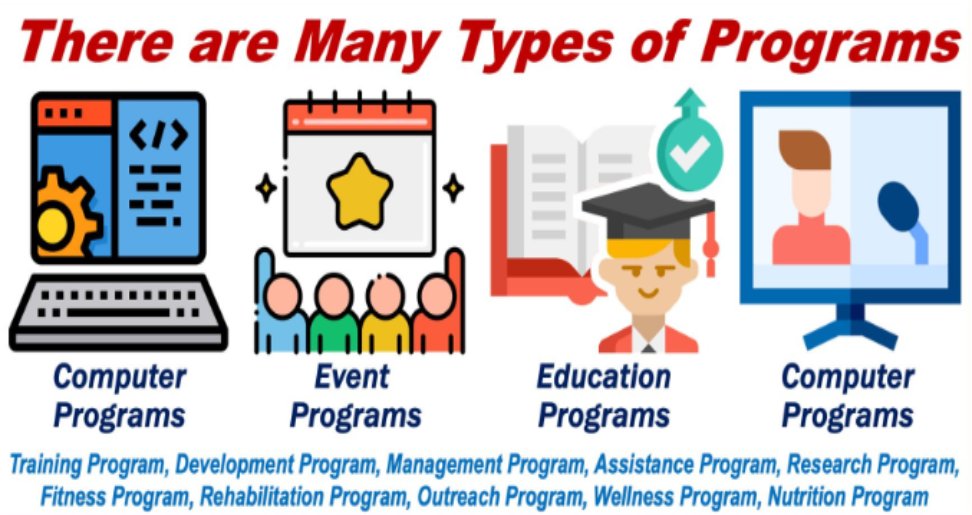In the intricate tapestry of our digital age, “programs” emerge as the invisible architects shaping our world. From the moment we wake to the time we rest, programs orchestrate countless actions, often silently and seamlessly. But what exactly are they?
At its core, a program is a sequence of instructions designed to be executed by a computer.
These instructions, written in specific programming languages, tell the computer what to do, step by step. Whether it’s calculating complex equations, processing information, or controlling physical devices, programs are the fundamental tools that make modern technology possible.
Types of programs

Programs, or software, are the intangible components that breathe life into computers.
They are instructions that guide the hardware to perform specific tasks. Broadly, programs can be categorized into two primary types:
System Software
System software is the foundational layer that manages the computer’s hardware and provides an interface for application software to interact with the system.
It acts as the intermediary between the user and the machine.
- Computer programs
Computer programs are essentially sets of instructions written in specific programming languages that a computer can understand and execute. These instructions dictate the computer’s actions, from simple calculations to complex problem-solving. Programs are built through a meticulous process of coding, testing, and debugging to ensure they function correctly and efficiently.
- Television/Radio programs
Television and radio programs serve as diverse platforms for entertainment, information, and education. From captivating dramas and comedies to informative news broadcasts and thought-provoking documentaries, these media channels cater to a wide range of interests and preferences.
- Educational programs
Educational programs are structured learning experiences designed to impart knowledge, skills, and values. They encompass a wide range of formal and informal settings, from classrooms to online platforms, and cater to diverse learners of all ages. Effective programs foster critical thinking, problem-solving, and lifelong learning.
- Event programs
We are thrilled to welcome you to this year’s [Event Name]! This event is a celebration of [briefly describe the event’s purpose or theme]. We have curated an evening filled with [mention key highlights, such as entertainment, networking, or fundraising]. Let’s come together to [state the desired outcome, such as inspire, connect, or support].
- Government or nonprofit programs
Government or nonprofit programs offer essential support to communities in need. They provide a safety net for vulnerable populations, address social issues, and promote economic growth. These programs often focus on areas such as education, healthcare, housing, and environmental protection, making a significant impact on the lives of countless individuals and families.
Characteristics of a program

A program, fundamentally, is a sequence of instructions that a computer follows to perform a specific task. Its effectiveness and maintainability are heavily influenced by certain key characteristics.
Core Characteristics
- Functionality:
- The primary purpose of any program is to accomplish a specific task or set of tasks.
- It should accurately and reliably perform its intended functions without errors.
- The program’s functionality should align with the problem it’s designed to solve.
- Reliability:
- A reliable program consistently produces correct results even under varying conditions.
- It should be robust to errors and unexpected inputs.
- Error handling mechanisms are essential to maintain reliability.
- Efficiency:
- An efficient program utilizes system resources (CPU, memory, disk space) optimally.
- It should execute tasks quickly and without unnecessary overhead.
- Optimization techniques can improve efficiency, but they should not compromise readability or maintainability.
- Usability:
- A usable program is easy for users to interact with.
- It should have a clear and intuitive user interface.
- Documentation and help features enhance usability.
- Maintainability:
- A maintainable program is easy to understand, modify, and update.
- It should be well-structured with clear code and meaningful comments.
- Modular design promotes maintainability.
- Portability:
- A portable program can run on different hardware and software platforms with minimal changes.
- It avoids platform-specific dependencies whenever possible.
- Cross-platform compatibility is essential for wider usage.
- Security:
- A secure program protects sensitive data from unauthorized access, modification, or disclosure.
- It should implement appropriate security measures to prevent vulnerabilities.
- Regular security updates are crucial.
- Flexibility:
- A flexible program can adapt to changing requirements without extensive modifications.
- It should be designed to accommodate future enhancements.
- Modular architecture facilitates flexibility.
- Readability:
- Readable code is easy for humans to understand.
- Consistent formatting, meaningful variable names, and clear comments improve readability.
- Well-structured code enhances readability.
Additional Considerations
- Scalability: The ability of a program to handle increasing workloads or data volumes efficiently.
- Reusability: The extent to which components of a program can be used in other projects.
- Testability: The ease with which a program can be tested to verify its correctness.
- Documentation: Comprehensive documentation is essential for understanding and maintaining a program.
Importance of programs

Programs, essentially sets of instructions executed by computers, are the bedrock of our modern digital world. Their significance spans across various domains, from everyday conveniences to complex scientific advancements.
Automation and Efficiency
- Task Repetition: Programs excel at performing repetitive tasks with unparalleled speed and accuracy, freeing human labor for more complex and creative endeavors.
- Process Optimization: By analyzing data and identifying inefficiencies, programs can streamline processes, reducing costs and increasing productivity.
- Time Savings: Automated systems powered by programs save time by handling routine tasks, allowing individuals and organizations to focus on strategic initiatives.
Problem Solving and Innovation
- Complex Calculations: Programs can process vast amounts of data and perform intricate calculations, enabling breakthroughs in fields like science, engineering, and finance.
- Data Analysis: By extracting meaningful insights from data, programs help identify patterns, trends, and opportunities for innovation.
- New Possibilities: Programs are the foundation for creating new technologies and applications, driving progress and shaping the future.
Communication and Collaboration
- Global Connectivity: Programs facilitate communication and collaboration across the globe, breaking down geographical barriers and enabling information sharing.
- Social Interaction: Social media platforms and online communities powered by programs connect people with similar interests and foster a sense of community.
- Knowledge Sharing: Programs enable the creation and dissemination of knowledge through online platforms, educational resources, and research databases.
Entertainment and Leisure
- Interactive Experiences: Games, movies, and virtual reality experiences are made possible through complex programs, providing entertainment and immersive experiences.
- Creative Expression: Programs empower individuals to create art, music, and other forms of creative content, sharing their talents with a global audience.
- Accessibility: Programs can make entertainment accessible to people with disabilities, providing inclusive experiences.
Economic Growth and Job Creation
- Industry Foundation: Many industries rely on software and programs, driving economic growth and job creation.
- Digital Economy: The rise of e-commerce, online services, and digital products has created new business opportunities and employment.
- Technological Advancements: Programs fuel innovation, leading to the development of new products and services that stimulate economic growth.
Challenges and the Future

While programs have brought immense benefits, they also present challenges. Cybersecurity threats, privacy concerns, and ethical implications are issues that require ongoing attention.
The future of programming holds exciting possibilities.
Artificial intelligence, machine learning, and virtual reality are driving innovation. As technology continues to evolve, programs will play an even more central role in shaping our world.
Conclusion
Programs are the invisible threads that connect our digital lives. From the simplest task to the most complex operation, they are the engines of progress. As we move forward, understanding the power and potential of programs becomes increasingly important for individuals and societies alike.
Read More :
Featured Image Source: https://tinyurl.com/26n4j7y3

